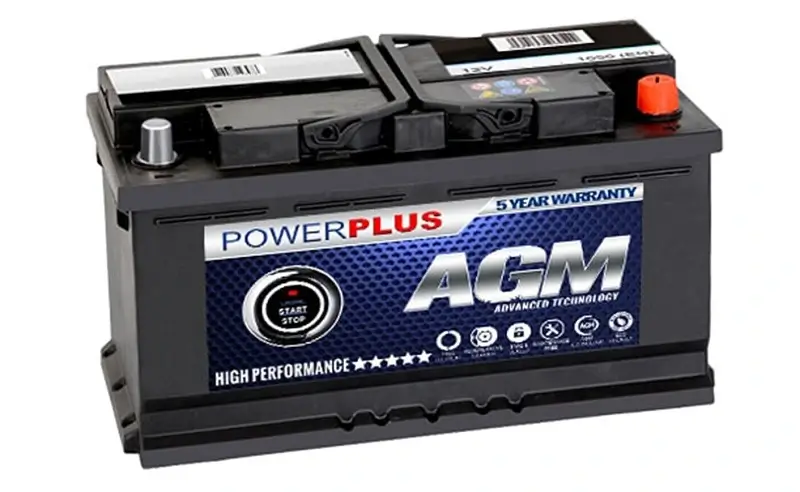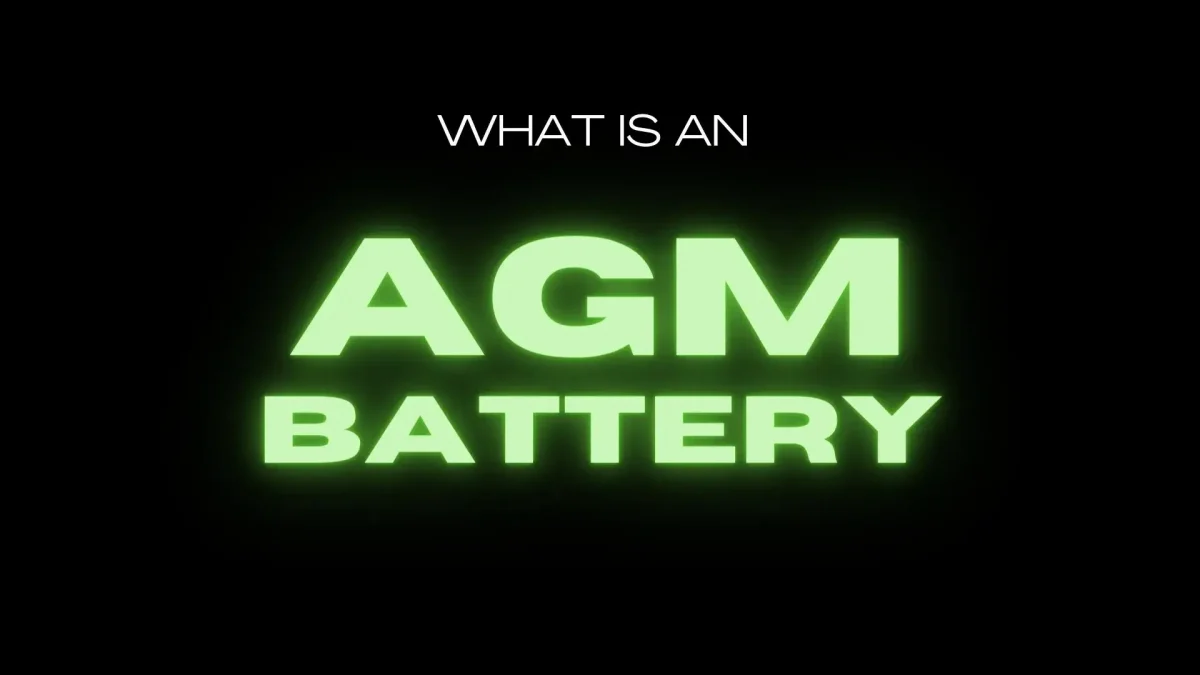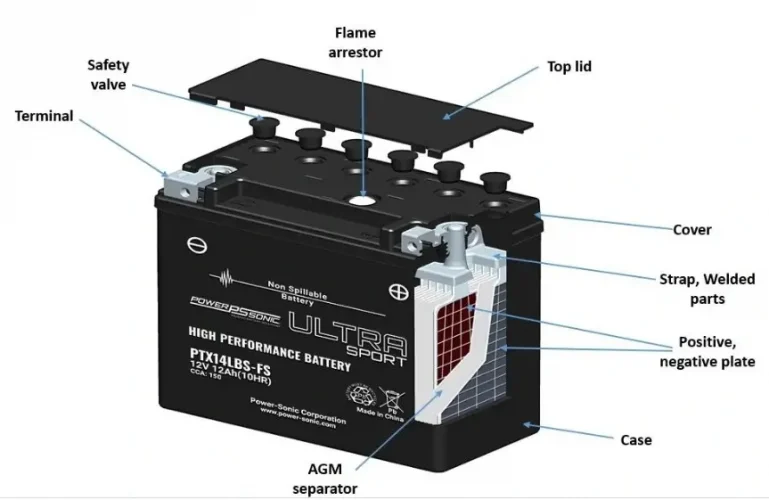We take an in-depth look at What is an AGM Battery!
We have been using batteries in vehicles for over a century. In the early days, lead-acid batteries were used in cars. But they are now old technology. Although many of us still use traditional lead-acid batteries in our cars, they have been superseded by Absorbent Glass Mat (AGM) batteries.
In this article, I’ll take a look at what AGM batteries are, how they work, and whether they are worth the extra cost.
Table of Contents
What Is An AGM Battery?

Absorbent Glass Mat (AGM) batteries are similar to conventional flooded lead acid (FLA) batteries. But unlike ‘traditional’ lead acids, they have an absorbent glass mat between the positive and negative plates. This replaces the free-flowing liquid electrolyte found in flooded lead-acid batteries.
The advantage of the AGM technology is that the glass mat absorbs the electrolyte. It is then placed in situ in solid form. This restricts the movement of electrolyte between the cells. In turn, this reduces spills and acid loss during usage.
The inclusion of the glass mat between the plates revolutionized battery technology. This created the first maintenance-free battery.
The chemistry of a ‘traditional’ lead acid battery is replicated in an AGM battery. Both types of battery use lead, sulfuric acid, and water to produce current.
The difference between an AGM battery and a conventional one is the thin glass mat between the plates.
There are several advantages to the technology, which include the following.
- No risk of electrolyte spilling.
- Lower electrolyte loss from discharging.
- More durable/resistant to vibration.
AGM Battery Construction / How Do AGM Batteries Work?
As current is drawn from the AGM battery, the acid molecules in the electrolyte transfer to the lead plates.
This process leaves behind lead sulfate and water.[1] To enable a chemical interaction between the lead paste coated on the plates, sulfuric acid is removed from the solution. This causes electrons to flow – electrical current.
Types Of AGM Batteries
There are two categories of AGM batteries.
- Lead-calcium.
- Thin Plate Pure Lead (TPPL).
Lead-Calcium AGM
Lead calcium batteries are still Lead Acid batteries. They release a powerful, quick charge to crank an engine. They are sometimes known as “SLI” (Starting, Lighting, and Ignition) batteries.
SLI batteries cannot be deep-cycled as this will cause damage.[2] They need to be attached to a recharging mechanism such as a car’s alternator to recharge after each use.
Thin Plate Pure Lead (TPPL)
TPPL batteries are more tolerant to deep cycle charging. They will allow discharging to 80% over 400 cycles.[3]
What Is The Difference Between Conventional And AGM Batteries?
Conventional lead acid batteries fall into the category of “Flooded” batteries. It means that the electrolyte flows freely across all cells in the battery. This introduces inefficiencies and prevents any acid spills.
AGM batteries have thin sheets of absorbent glass mat installed between the positive and negative cells. It prevents the electrolyte from flowing freely across the battery cells.[4]
When Is A Conventional Battery Best?
Flooded Lead Acid batteries are the cheapest battery technology. They are also the least efficient. They have a shorter estimated lifespan than their successors.
Conventional batteries are the cheapest battery type available. They are suited for most requirements. These include short power applications (SLI) or low levels of power drain over a longer period (Deep cycle).
They are suitable for powering the following.
- Gas-powered cars which do not have consistently large draws of power.’
- Motorcycle engines.
- Radios at a camping site.
- Camping lights.
What Are The Pros And Cons Of AGM Batteries?
While AGM batteries are an upgrade from traditional lead acid batteries, there are several pros and cons associated with their use.
Pros of AGM Batteries
The advantages of using AGM batteries are listed below.
- Faster charging than conventional batteries.
- Hold the charge longer than conventional batteries.
- They can be stored on their sides.
- Much more durable – can handle extreme vibration.
- Sealed, with no chance of them spillage.
- AGM batteries do not vent gas under normal circumstances.
- Maintenance free.
- Longer life span than conventional lead acid batteries.
- TPPL AGM batteries can be used in a solar-powered system.
Cons of AGM Batteries
The disadvantages of using AGM batteries are listed below.
- AGM batteries will sustain damage if overcharged.
- More expensive than conventional batteries.
Are AGM And Gel Batteries The Same?
AGM and Gel batteries both use the same lead acid principle but differ in construction. The chemistries of flooded, AGM, and Gel batteries are very similar. But, like AGM batteries, Gel batteries don’t contain liquid electrolyte. Like AGM batteries, they are also low maintenance and sealed.
Their cells are in separate tight compartments, which prevents movement. The electrolyte is mixed with a silica gel.[5] This changes its consistency into a jelly-like substance.
This silica gel keeps the electrolyte in a partially solid state. But it still allows electrons to flow from the negative (-) plates to the positive (+).
AGM Vs. Flooded Battery
The difference between an AGM and a flooded battery is in the absorbent glass mat between the cells.
A flooded battery allows the electrolyte to flow freely between the plates. This introduces inefficiencies. The absorbent glass mat contains the electrolyte and reduces movement across the cells.
It introduces greater efficiencies and prevents any acid spills.
When Are AGM Batteries Used?
AGM batteries are a maintenance-free version of flooded batteries. So you can use them in any application suited to FLA batteries.[6]
They provide pulse power suitable for car starter motors. Lead calcium AGMs are SLI batteries. They should not be deeply discharged. They should be topped up with a constant recharging system such as a car alternator.
It makes them suitable for powering:
- Gas-powered cars which do not have consistently large draws of power.’
- Motorcycle engines.
- Boats
- Radios at a camping site.
- Camping lights.
- Garden applications.
How Is A Lithium Battery Different From AGM
The technologies applied in AGM and Lithium batteries are completely different.
The following describes the basic working of a Lithium-ion battery.
The components of a Lithium-Ion Battery include:
- an anode
- a cathode
- a separator
- an electrolyte
- positive and negative collectors
The cathode and anode store the electrical current. When an electrical current is drawn from the battery, the electrolyte transports the positively charged ions from the anode. They proceed across the separator, to the cathode.[7]
When the ions move, electrons are produced at the positive collector. They are then used to power the consumer.
When the battery is recharged, the whole process is reversed.
Lithium-ion batteries weigh less and last longer. They can be discharged to 15% without any degradation in capacity.
Frequently Asked Questions
Here are some FAQs.
How Long Do AGM Batteries Last?
AGM batteries last longer than conventional lead acid batteries. They can be expected to last between forty-eight to sixty months, depending on the type.
Can You Use a Regular Battery Charger On an AGM Battery?
Most conventional 12-volt battery chargers can be used to recharge AGM batteries. A smart charger with an AGM setting is the optimal device to charge AGB batteries.
Are AGM Batteries Deep Cycle?
Lead-calcium AGM Batteries are not deep-cycle batteries and should not be deeply discharged. Thin Plate Pure Lead (TPPL) AGM Batteries can tolerate deep cycles of 80% discharge.
Do AGM Batteries Work With Solar Panels?
Thin Plate Pure Lead (TPPL) AGM Batteries can be used with solar systems. But Lithium-Ion batteries are better suited.
Are AGM Batteries Recyclable?
More than 98% of an AGM battery can be recycled.
Conclusion – What Is An AGM Battery?
AGM batteries are a worthwhile choice when used in the applications for which they were designed.
Typical applications would be replacing a flooded lead acid battery in a car. Or using a solar power system with an RV where the number of charging and discharging cycles is not long-term.
AGM batteries are superior to conventional FLA batteries. You would expect that. AGMs are a later generation of batteries, and technology advances constantly. So in whatever application you want to use a battery, AGMs are the way to go if you can afford them.
Like What Is An AGM Battery? Check out our Related Articles


